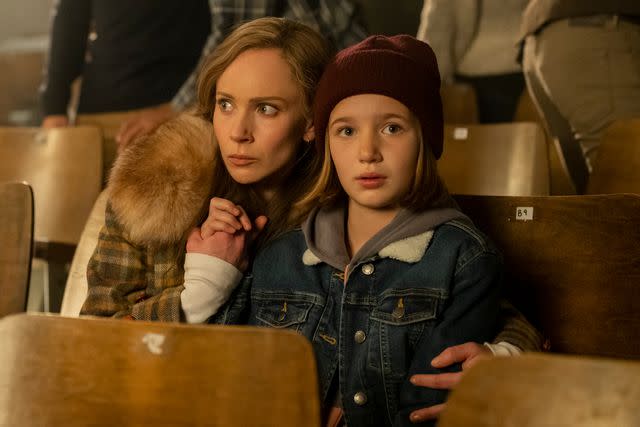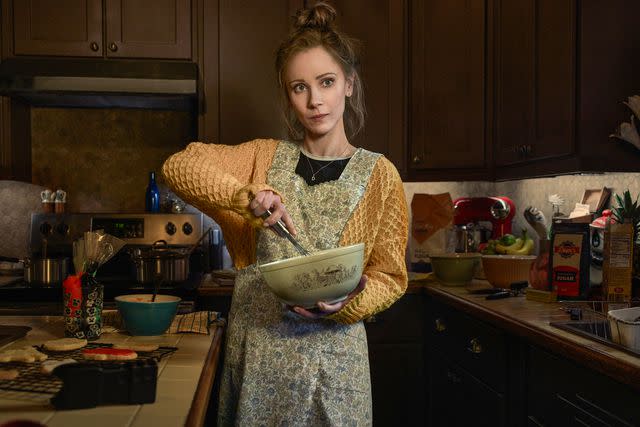“Fargo” showrunner talks recreating the film's kidnapping scene in season 5 premiere and Roy's obsession with Dot

- Oops!Something went wrong.Please try again later.
"After 41 hours in 'Fargo,' it was kind of amazing to be behind the camera and filming a scene from the movie," Noah Hawley tells EW.
WARNING: This article contains spoilers for the Fargo season 5 premiere, "The Tragedy of the Commons," and episode 2, "Trials and Tribulations."
Who knew tasering a police officer at a school board meeting could lead to setting a man’s face on fire, getting kidnapped, and landing in a high-stakes gas station shootout all in less than 24 hours?
Well, Dorothy “Dot” Lyon (Juno Temple) certainly knew from the moment her fingerprints were taken at the station that her mysterious past was bound to haunt her in the season 5 premiere of FX's anthology series, Fargo. After surviving the ordeal — which she denies ever happened — Dot spends the series’ second episode preparing for her inevitable round two against sheriff Roy Tillman (Jon Hamm).
To find out what lies ahead for Dot this season, EW spoke with showrunner Noah Hawley about the premiere and why Roy won't stop until he gets her back.
ENTERTAINMENT WEEKLY: The premiere is filled with nods to the original Coen Brothers film, from the definition of “Minnesota Nice” to “it’s a beautiful day,” to Dot's kidnapping scene.
NOAH HAWLEY: We literally recreated the beginning of the kidnapping with Juno while she's knitting and watching the morning show. We designed the house not to be the same, but to have the same points of view of the porch outside and the guy coming up and it was really, I must say, after 41 hours in Fargo, it was kind of amazing to be behind the camera and filming a scene from the movie. It raises the hairs on the back of your neck to be standing on some of those sets and feeling like I'm in the movie.
How did you balance keeping the essence of the original film when developing this season of Fargo?
I really wanted to riff on the movie in a way. Bill Macy is a major character in the movie. Steve Buscemi and Peter Stormare are major characters in the movie. Father-in-law, major character in the movie. Wife? Not so much. And I thought that was an interesting opportunity to say, 'Okay, well, let's put the audience in a position where they're watching something they've seen before, and then their brains are going to tell them what happens next….’ But we're going to do a different version of that, and the story is actually the story of the wife.

Michelle Faye/FX
Juno Temple and Sienna King in 'Fargo'The first episode opens with Dot being arrested after she tasers a police officer during a school board meeting turned brawl. How did this become the season’s inciting incident?
It was sort of the inciting image in my mind. Just as I wanted to tell a story that was more concise and propulsive, I wanted to hard start and I thought that this idea of Minnesota Nice… that's what Fargo's built on, this idea that some people will act nice no matter what they're thinking. To define the term Minnesota Nice and then open with this school board brawl, it felt like both a good joke, but also now you're completely oriented. Then when you find Dot in the middle of this crowd, she's the only one who's not engaged in some kind of 'nobody's listening to me' aggression. You go, ‘Okay, so she is the one decent person left who still thinks that people shouldn't act like this toward each other.’ It tells you a lot very quickly in a series of images.
It all kicks off when two men break into Dot’s house and she defends herself by lighting one of their faces on fire. Did you experiment with having Dot use any other household items to protect herself?
I mapped it out pretty clearly. There were definitely moments on set where I saw an opportunity and I played with [it], even some design elements. Dot’s described as a tiger, and I wanted this reveal that one wall of her bedroom is this jungle mural that's almost hiding the pocket door to the bathroom that she's hiding behind, and she comes out and she's ferocious like a tiger. Then when she's finally captured, she's in the kitchen and the wallpaper she's standing in front of is these bars; she's gone from the jungle to the jail. These kinds of elements are a nice discovery [from] walking the space and talking through the sequences, and things that most people in the audience might never notice or realize but I think, subconsciously, they have an impact.
When fleeing her captors at the gas station, Dot stops when she spots a box of Bisquick. She pauses again when she sees the breakfast menus after the fight. What does breakfast signify in this episode?
I was two days into a four-day shoot in that gas station and I was on my way into set that morning and I felt like I needed something more emotional. I made some calls and said, ‘I need some Bisquick on the shelves, and I need these flyer foldouts about breakfast [being] the most important meal of the day,’ and we went back and we added those elements in the middle. I think it really does make all the difference, because it connects her to her family without saying anything. She stops, she looks at it, and we know exactly what it represents. Then when she's standing victorious and the cops are coming and she sees that sign about breakfast, she knows that if she allows the cops to arrive and she goes with them then her life will never be the same again. So she escapes, goes home, and tries to force herself back into that life without acknowledging what happened to her.

Frank W Ockenfels III/FX
Juno Temple in 'Fargo'Dot has a moment with her husband Wayne (David Rysdahl) where she admits that she can’t always be the perfect wife that people expect her to be all the time. How does her family shape her viewpoint moving forward?
I don't think [Dot] had a safe home growing up or a real sense of family. Then she was [taken in] by Roy and his then-wife, abused in that situation, ended up marrying Roy, and then escaped. I think when she found Wayne, she finally found a home that felt secure and she's going to be damned if she surrenders it or if they force her to leave it when she was just trying to save her own life. I think it's powerful, but I think it is her resilience and the fact that she always looks on the bright side that makes us really love her. She's not gonna let this world force her to be a negative person.
Viewers meet Roy Tillman in episode two. What can you tell us about him and his goals for this season?
Roy is a constitutional sheriff they call it, which is a group of sheriffs in America who believe that the Constitution gives them more authority than the President. They are the law, which is certainly what he says and what he believes. There's an echo of No Country for Old Men and Tommy Lee Jones in there certainly, but I've just taken that element that Tommy Lee Jones has of, 'Yeah, I don't need to meet with the FBI because I'm the boss here and I do my own thing,' and I've just turned that up to a sort of logical conclusion, which is a rejection of all other forms of authority except his own.
He's on his third wife now. Dot was the second wife, and he's abusive, and she escaped, and he can't allow that. He can't allow someone to reject his authority. And so the moment he realized that she's still out there, he comes for her, and he's not going to stop until she's in front of him and he, in his mind, apologizes.
This interview has been edited for length and clarity.
Fargo airs Tuesdays at 10 p.m. ET/PT on FX and streams the next day on Hulu.
Sign up for Entertainment Weekly's free daily newsletter to get breaking TV news, exclusive first looks, recaps, reviews, interviews with your favorite stars, and more.
Related content:
Read the original article on Entertainment Weekly.

